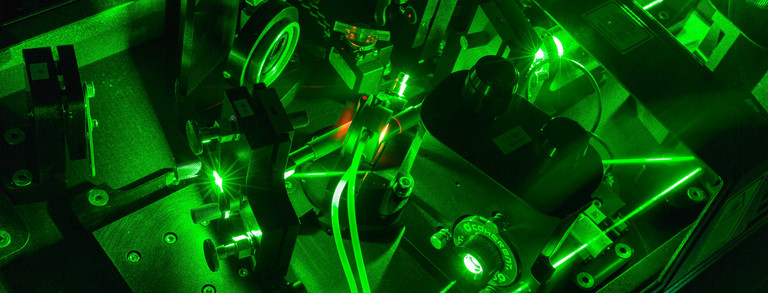ODNMR
What is ODNMR
Since the early 1980s Optically detected nuclear magnetic resonance (ODNMR) has been used as an effective tool for
studying the dynamics of nuclear polarization in bulk semiconductors. In comparison with conventional NMR methods this measurements has shown a very high sensitivity. As nanostructures, like quantum dots (quantum wells...), appears conventional NMR methods were unable to detect a direct response from the nuclearspinsystem because of the small amount of nuclears in nanostructures. One of the features of nanostructures is the strong coupling between the electronspin and nuclearspinsystem because of the strong localisation of the electron. This coupling enable to detect an electron-hole recombination that is influenced by the nuclearspinsystem. The ODNMR method use this coupling to get information about the nuclearspinsystem by measuring the photoluminescence.
Converntional NMR methods:
To observe an absorbtion of an radiofrequency signal it is need to create a large population difference between the split energy levels of the nuclearspin. So typically external fields of several Tesla are needed to observe an NMR signal.
ODNMR measurements:
The effect of optical pumping is used to increase the population difference between the split nuclearspin levels. This effect describe the transfer of angular momentum from circular polarized light to the electron and finally the transfer of the angular momentum from the electron to the nuclearspinsystem. The created difference in population is strong enough to observe an absorbtion of a radiofrequency signal even in a few milli Tesla.
Experimental setup
A TiSa-Laser can be tuned from 750nm-950nm to excite the Sample. In addition two optical modulators (electro-optic and acousto-optical modulator) are in use. The EOM change the polarization between horizontal and vertical linear polarized light with a repetition of 1.4MHz. In combination with a λ/4 the sample will be excited by circular polarized light. The AOM can interrupt the excitation so that the shortest laser-pulses has a duration of about 200ns. The sample can be cooled down to 1.8K inside of an optical Cryostat. The superconductive insert can reach up to 1T and be oriented in Voigt- or Faraday-configuration (mag. field normal or parallel to optical axis). The photoluminescence can be detected by a combination of a monochromator + CCD or a monochromator + averlanced photodiode with a grating of 600g/mm.
Typical experiment
All measurements are performed on self assembled quantum dots and the main interest is to measure the degree of polarization of the photoluminescence in the dependence of an external magnetic field that is applied perpendicular (Voigt-geometry) to the optical axis. The polarization degree of the photoluminescence is proportional to the z-component (z-component is parallel to optical axis) of the excited electron. By applying a transverse mag. field one can observe a degreasing of the polarization degree of the photoluminescense. It means that a dephasing of the excited electronspin is observed. This effect is called the Hanle-effect and by sweeping the transverse mag. field one can observe the Hanle-curves.
Without the influence of the nuclearspinsystem the dephasing of the elctronspin has a lorentzian shape. If an interaction between the excited electron and nuclearspinsystem appears one can observe it on the Hanle-curve. The easiest measurement, where an influence of the nuclearspinsystem is observable, is to excite the sample permanent with circular polarized light. This leads to a polarization of the nuclearspins and causes a nuclear magnetic field that is oriented along the external mag. flied. In this situation the Hanle-curve shows a W-structure.
Main Results
Influence of strain on the Zeeman-splitting
Measurements has shown, that in small external mag. fields the strain effects change the energy levels of the zeeman splitting. Some of the Zeeman levels are still degenerated and don't split up to severel tens of mT. One reasons for the strain is the lattice mismatch of the substrate and the quantum dot an other is the exchange of some nuclei due to a high annealing temperature of the sample. It was possible to identify the nuclear magnetic resonances and to calculate the direction and the magnitude of the strain within the quantum dots.
Selective polarization of nuclei
By simultaneously irradiation the sample with polarized light and applying an oscilating mag. field it is possible to polarize selectivelly one isotope within a quantum dot.
Calculation of spindynamic for different nuclei
The nuclei that are influenced strongly by the strain has different times for plarization and dephasing then nuclei that are less influenced by strain. It is possible to calculate this times for nuclei.
Current Offers For Bachelor-, Master- or PhD-Theses
Bachelor- and Master-theses are offered in relation to the ongoing research. Feel free to ask for more information!
Contact
- Prof. (apl.) Dr. Dmitri Yakovlev
Collaborations
- St. Petersburg State University, Russia
- Ioffe Physical-Technical Institute, Russian Acadamy of Sciences



